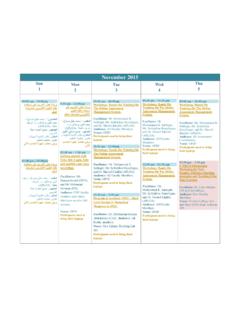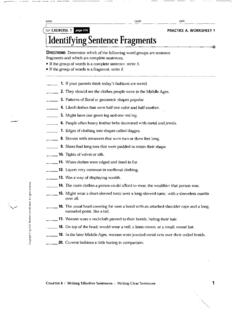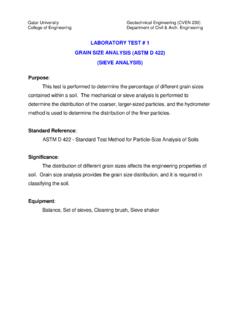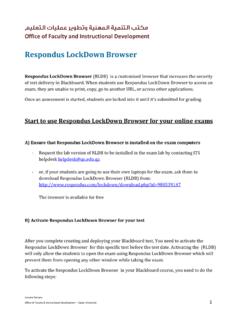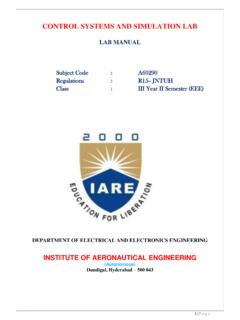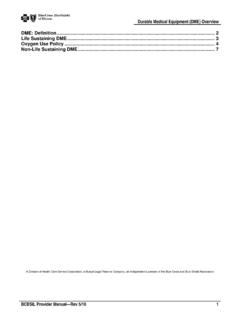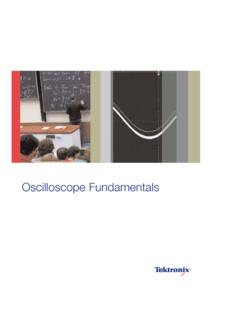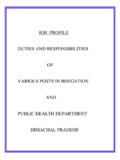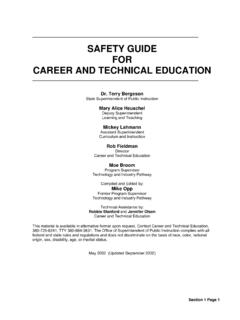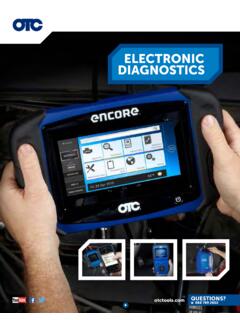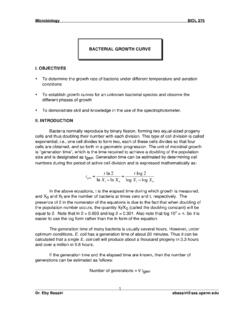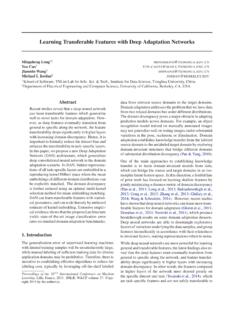Transcription of Lab. Manual Fluid Mechanics - Qatar University
1 Lab. Manual of Fluid Mechanics The Department of Civil and Architectural Engineering General Safety rules to be followed in Fluid Mechanics Lab: 1. Always wear shoes before entering lab. 2. Do not touch anything without the permission of instructor/lab assistant. 3. Read carefully the lab Manual before performing experiments. 4. Check electrical connections before starting the equipment. 5. Do not put your hands while the machine is in operation. 6. Do not tamper measuring instruments. 7. Do not open the casing of the equipment. 8. Do not unplug any electrical connection. 9. Switch off the power supply to the experimental setup on completion of the experiment. 10. Do not leave chemical containers on the working tables. 11. Use safety goggles wherever necessary. List of Experiment Experiment No: 1 Calibration of a Bourdon Pressure Gage Experiment No: 2 Pressure Measurement Bench Experiment No: 3 Center of Pressure on Submerged Plane Surface Experiment No: 4 Coefficient of Discharge for a Rectangular Notch Experiment No: 5 Coefficient of Discharge for a Venturi Experiment No: 6 Head Loss due to Friction in a Smooth Pipe Fluid Mechanics , CVEN 212 1| Expt.
2 1 Experiment No: 1 Calibration of a Bourdon Pressure Gage Objective: To calibrate a Bourdon type pressure gage and to establish the calibration curve of Bourdon Gage. Also determine the gage errors. 1. Apparatus: i. Dead Weight Calibrator. ii. Set of Test weights iii. Weight balance. iv. Bourdon pressure gage. Introduction Instrument calibration is one of the primary processes used to maintain instrument accuracy. It is the process of configuring an instrument to provide results within an acceptable range. Known weights have been applied on a Dead Weight Calibrator to apply pressure to a Fluid for checking the accuracy of readings from a pressure gage. Various types of pressure measuring instrument have been used to measure the pressure intensity at any point in static or moving Fluid .
3 One of these devices is the Bourdon tube pressure gage. Bourdon-tube pressure gages are most widely used now-a-days because of their reliability, compactness, low cost and ease of use. It consists of a curved tube (Figure 1) of elliptical cross-section bent into a circular arc. Figure 1:Dead Weight CalibratorFluid Mechanics , CVEN 212 2| Expt. 1 When pressure is applied to the tube, it tends to straighten out, and the deflection of the end of the tube is communicated through a system of levers to a recording pointer. This gauge is widely used for steam and compressed gases. The pressure indicated is the difference between the system pressure and to the external (ambient) pressure, and is usually referred to as the gauge pressure Related Theory: The bourdon gage is the most popular pressure measuring device for both liquids and gasses.
4 It can be connected to any source of pressure such as a pipe or vessel containing a pressurized Fluid . I. Bourdon Gage: The Bourdon Gauge (Figure 2) is fitted with a transparent dial, which lets you see the internal workings of the gauge. The gauge consists of a thin walled closed ended tube which is oval in cross section. This tube is bent through an angle of about 270o along its long axis. The open end of the tube is welded to a hollow mounting block which allows the pressurized Fluid to reach the tube. This causes the pressure from the source to be transmitted directly to the inside of the bourdon tube. The applied pressure causes the oval tube to become rounder (since a round cross section has the maximum area for a given circumference). As it becomes rounder, the bourdon tube tends to uncurl which causes its free end to move.
5 A system of linkages and levers transmits this motion to the gauge needle which moves over the scale. Figure 2: Bourdon Gage Fluid Mechanics , CVEN 212 3| Expt. 1 II. Dead Weight Calibrator: In order to obtain very accurate pressure measurements, it is essential to regularly re-calibrate the gauge. This is because the tube tends to become weaker with extended use. The usual procedure is to apply a known pressure to the gauge using a device called a Dead Weight Calibrator. The normal calibration procedure is to load the gauge for known pressures, using a dead weight calibrator including a liquid of known specific gravity (use water as the liquid). This dead weight tester uses a simple piston and cylinder arrangement to provide a source of pressurized liquid (in the experiment water will produced a better result than oil) which is transmitted to the gauge.
6 Since the true pressure of the liquid can be easily calculated, the value can be compared directly to the reading on the gauge over the complete scale range. (The scale range is the range of pressures from zero to the full-scale deflection value). The dead weight tester consists of a cylindrical piston which is free to move vertically in a close fitting cylinder. A Platen is attached to the piston which can be loaded with a series of accurate weights. The pressure developed in the cylinder is transmitted via a transparent tube to the gauge under test. The cylinder is mounted on a base board which is supported on leveling screws and fitted with a spirit level. Governing Equations: The use of the piston and weights with the cylinder generates a measurable reference pressure: , Where, F = Force applied to the liquid in the calibrator cylinder in Newton (N).
7 M = Total mass including the mass of the piston in kilogram (kg). A = Cross-sectional area of the piston in square meter (m2). g = Acceleration due to gravity in meter per square second (m/s2). Fluid Mechanics , CVEN 212 4| Expt. 1 Equipment Set Up: Position the calibrator without the piston on the hydraulic bench top and ensure that the base is horizontal by adjusting the feet and using the spirit level. This is necessary to ensure vertical transfer of the applied load and free rotation of the piston. Open all cocks on the pressure gage base. Connect the inflow cock to the bench flow connector and the outflow cock to the lower tube from the calibrator cylinder. Open slowly the bench valve to produce a flow, tilt the pressure gage to ensure that air is driven out from the manifold and then close the middle cock on the manifold. When there is no further air emerging and the calibrator cylinder is full, close the bench valve and the inflow cock on the manifold.
8 Data for the Piston: a. Mass of the piston (Mp) = 498g b. Diameter of the piston (d) = Procedure: 1. Measure the weight of the calibration masses. 2. Note down the weight of the piston and it s cross sectional area. 3. Remove the piston and pour the water into the cylinder until it is full to overflow level. Any air trapped in the tube may be cleared by tilting and gently tapping the apparatus. 4. Insert the piston carefully and spin it to minimize any friction effects. 5. Note the pressure reading from the gage. 6. Add the weights in convenient increments, and at each increment, observe the pressure gage reading. 7. Take the similar sets of readings with decreasing weights. Note: If due to the slight leakage, piston reaches the cylinder bottom, more water must be added to the cylinder.
9 Fluid Mechanics , CVEN 212 5| Expt. 1 Table of Observations and Calculations: All readings and calculations are to be tabulated as follows: Mass (kg) Actual Pressure (kPa) Gage Reading (kPa) Percent Error (%) Loading Unloading Loading Unloading Relative Error = (Measured Value Actual Value) /Actual Value Percent Error = Relative Error 100 Note: Also, show the sample calculation to calculate the Relative Error and Percent Error. Graphical Relationship: Plot the following graphs: 1) Actual Pressure against Measured Pressure (Gage Reading). 2) Percent Error against Measured Pressure (Gage Reading). Conclusion and Recommendations: Comment on the accuracy of the gage. Is the relative height between the calibrator and the gage important in calibration? General comments about the experiment Your recommendations. Fluid Mechanics , CVEN 212 Lab Manual 1| Expt.
10 2 Experiment No: 2 Pressure Measurement Bench Objective To get familiar with different pressure measuring instruments and to verify the theoretical manometer equation for measurement of pressure. 2. Apparatus i. Pressure measurement bench ii. U- tube Manometer filled with mercury iii. Bourdon pressure gauge iv. Pressure transducer Related Theory Pressure of a Fluid is the normal force exerted by a Fluid on a unit area. The pressure designated will be either an absolute pressure or a gauge pressure. Absolute pressure is measured relative to a perfect vacuum (absolute zero pressure), whereas gauge pressure is measured relative to the local atmospheric pressure. Absolute pressures are positive, but gauge pressure can be either positive (above atmospheric pressure) or negative (below atmospheric pressure) as shown in figure 1. U-tube manometers, bourdon gauge and the pressure transducer used in this experiment to measure the pressure.
